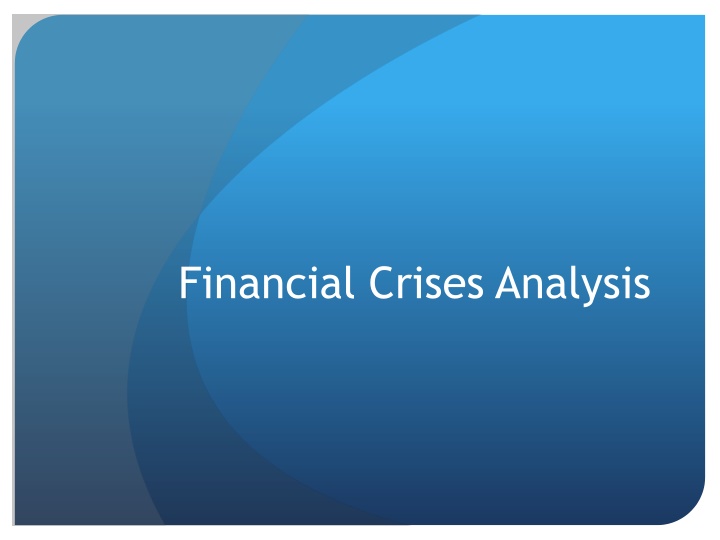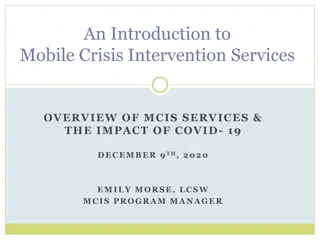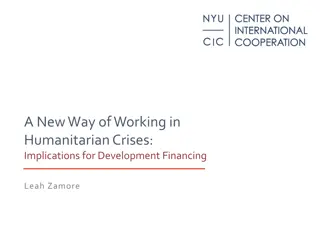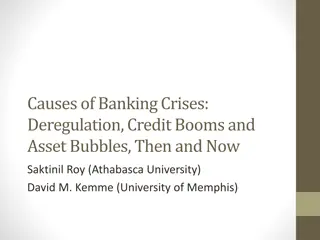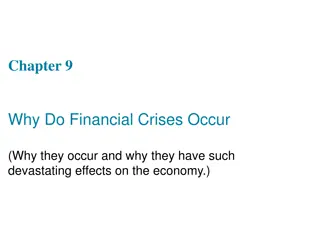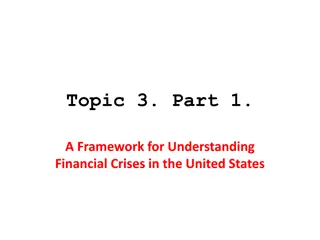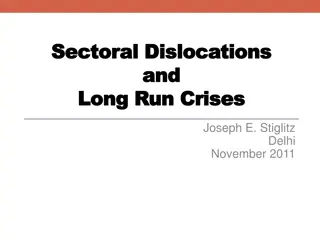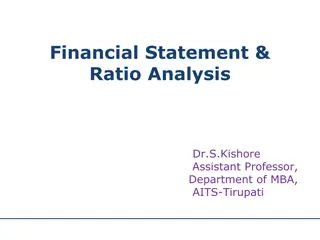Analysis of Financial Crises: Causes and Impact
Explore the causes and effects of major financial crises such as the Asian Financial Crisis of 1997-1999 and the 2008 Financial Crisis. Understand how weaknesses in the financial sector, risky lending practices, and government policies contributed to these global economic downturns. Discover the timeline of economic and political responses to these crises in countries like Thailand, South Korea, and Indonesia.
Download Presentation

Please find below an Image/Link to download the presentation.
The content on the website is provided AS IS for your information and personal use only. It may not be sold, licensed, or shared on other websites without obtaining consent from the author.If you encounter any issues during the download, it is possible that the publisher has removed the file from their server.
You are allowed to download the files provided on this website for personal or commercial use, subject to the condition that they are used lawfully. All files are the property of their respective owners.
The content on the website is provided AS IS for your information and personal use only. It may not be sold, licensed, or shared on other websites without obtaining consent from the author.
E N D
Presentation Transcript
Overview Asian Financial Crisis July 1997-1999 Mainly South East Asian Countries Started in Thailand 2008 Financial Crisis US housing bubble burst Bailout of banks Led to 2008-2012 global recession
Causes: Asian Financial Crisis Financial sector weaknesses Large PE ratio in market Borrowing in foreign currency Poor supervision Problems in external sectors Large current-account deficits Dependency on exports Unsound investments Real Estate bubbles Contagion effect Wake-up call hypothesis
Causes: 2008 Financial Crisis Subprime lending Mortgage lenders relaxed standards to lend to risky borrowers Housing bubble- peak 2006 Risky borrowers drove prices up Easy credit conditions Lower interest rates 2000- Low fed funds rate- 1% Foreign funds Deregulation of banking 1970s onward- government policy: Lack of supervision
Timeline of Economic/Political Policies: Asian Financial Crisis Thailand July 2, 1997: Thai government forced to float baht August 5, 1997: Adopts IMF measures for $17 billion loan Dec 8, 1997: Government closes 56 insolvent finance companies South Korea Nov 17, 1997: Bank of Korea allows won to drop- 1000 to USD Dec 3, 1997: IMF approves $57 billion bailout Dec 23, 1997: World Bank gives $3 bill Jan 28, 1998: International banks agree with SK to exchange $24 bill of short-term debt to longer-term loans Indonesia Oct 31, 1997: IMF gives loan package of $40 bill. Gove closes 16 banks Jan 8, 1998: Rupiah divas with President Suharto s state budget plan March 9, 1998: IMF delays $3 bill installment of loan package because of Suharto May 5, 1998: Student riots against Suharto May 22, 1998: Suharto resignns
Timeline of Economic/Political Policies: 2008 US Financial Crisis South Korea Sept 26, 2008: Bank of Korea injects into currency swap market Jan 2009: Government delivers massive fiscal programme Quarter of program for tax cuts and income/labour support Indonesia Sept 15, 2008: Gov reduces overnight repo rate to 10.25% China Sept 15, 2008: Government cuts interest rate for first time since 2002 Nov 9, 2008: Chinese economic stimulus plan- 4 trillion RMB Nov 28, 2008: Rise in export tax rebates Government trying to spur economic expansion
Statistics GDP
Statistics GDP Growth Rate
Effects: Asian Financial Crisis Thailand: Large unemployment rates Devalue of real estate and construction Baht devalued South Korea Bank failures/bank takeovers Moody downgrade- A1 to A3 Stock market fell Indonesia Rupiah put on floating exchange rate Rupiah drops
Effects: II Asian Financial Crisis China Forced to devalue currency for competitiveness Became largest exporter Fixed many issues of financial weakness
Recovery: Asian Financial Crisis Thailand 2001- Thailand s economy recovered Balanced budget 2003- repaid IMF debts South Korea GDP per capita tripled Nation debt-to-GDP ratio more than doubled Indonesia Rupiah never recovered- Dec 1998- 8,000 rupiah to 1 USD China Unaffected by crisis
Economic Forecast Only Thailand experienced recession China, South Korea, Indonesia experience slowdowns Dependant on exports to US Forecast: 2012- 3.5% growth in world GDP 2013- 4.1% growth in world GDP Emerging Asia to be economic leaders in growth China: Trade balance decreased greatly from crisis- 2009 decreased by 10% China to shift from export production to export for domestic consumption Domestic consumption needs to rise as share of GDP 12th5-year plan- boosting consumption and household income
